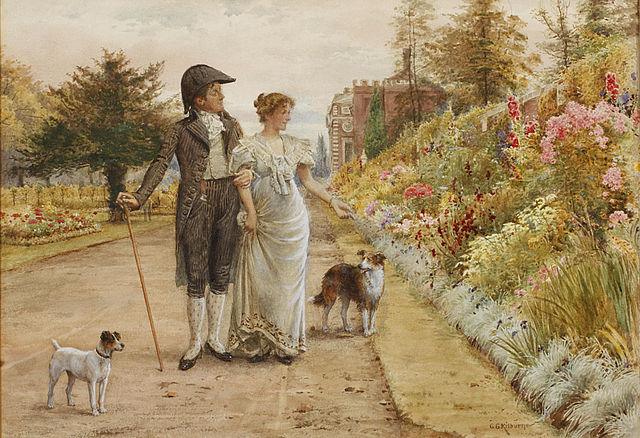Sedan Chairs
"Though I came only yesterday, I have equipped myself properly for Bath already, you see," (pointing to a new umbrella); "I wish you would make use of it, if you are determined to walk; though I think it would be more prudent to let me get you a chair."
Persuasion
The first sedan chair appeared in England as early as 1581, but was shunned by the public. In fact, in the early 1600's when the Duke of Buckingham began to use one, he incurred public censure for making human beings do the work of animals. However, by the time Sir Saunders Duncombe introduced his chairs opinion had changed. In 1634, Sir Saunders Duncombe patented his own version of the sedan chair and obtained a monopoly on the rental of "hackney chairs" for fourteen years and "sprang some forty or fifty specimens upon a willing and even eager public" (Walsh). Elaborate costumes and coiffures were now in fashion and the sedan chair offered the surest way of travelling through filthy streets without getting rained on, splattered with mud, or having a coiffure ruined. The sedan chair was cheaper than hackney coaches, and a person could not only travel from door to door in a sedan chair but could travel from indoors to indoors without setting foot outside.

The sedan chair was usually painted black outside and upholstered inside. Windows were fitted on three sides, though the front poleman necessarily presented the passenger with a view ahead consisting mainly of his back. The poles were long and springy enough to impart a slight bounce to the ride. The poles threaded through metal staples on the sides of the body of the chair. They could be quickly removed when the chair was not in use. Passengers entered and departed at the front, between the poles if they were in place. Riders didn't have to stoop too low because the sedan’s roof hinged at the rear (see print). It could be lifted to better accommodate exits. Once within the chair passengers had to trust to the chairmen’s competence, surefootedness, and skill in synchronising their pace and manoeuvres.
Cesar de Saussure, a foreign visitor to London in 1725, wrote: "the bearers going so fast that you have some difficulty in keeping up with them on foot. I do not believe that in all Europe better or more dexterous bearers are to be found; all foreigners are surprised at their strength and skill."
Although pedestrians were expected to give way when a chair bore down on them, the men shouted warnings of "Have care!" or "By your leave, sir!", there was always a possibility of a collision at street corners. Many of the wealthy owned their own sedan chairs but hired chairmen to carry them as the need arose.
There were also public chairs that waited on stands in the street just as hackney coaches did. London and Westminster issued 300 sedan chair permits in the early 1700's. The chairmen were licensed and had to display a number. It cost 1 £ 1 shilling to hire a sedan chair for a week. Chairmen wore a distinctive uniform, varying slightly over the decades and between winter and summer. It consisted of a blue kersey coat or greatcoat, black knee-breeches, white stockings or gaiters, buckled shoes, and large cocked hat. 
Chairs were available at any hour of the day or night. There was a long-established rule of paying the chairmen double fare for transport after midnight. At night a link-boy's torch lighted the way for the chairmen. Lady Mary Wortley Montagu gossiped about a lady and gentleman neighbour who escaped from a house fire in only their nightclothes and had to take cramped refuge in a passing sedan chair, which were always made to be single-seat. When Horace Walpole's house was broken into in the small hours of the morning, a couple of chairmen responded to the alarm and helped to capture the burglar.
Some chairmen were less helpful: "Two of them, very drunk, carrying home the prim, terrified, and abstemious Mrs. Herbert, opened the top of the chair and told her indistinctly: 'Madam, you are so drunk, that if you do not sit still, it will be impossible to carry you'" (White). Swearing, the commonest misdemeanour, incurred fines ranging from one to ten shillings, but more serious offences brought suspension or discharge.
In England the two-man chair survived well into the 1800's because it was quicker to walk than ride in London's narrow, uneven streets, but it was unsafe to walk in many areas. Eventually the sedan chair was superseded by the cab. Charles Dickens includes an episode about a sedan chair in Pickwick Papers.
Walsh, William Shepard. A Handy Book of Curious Information (Detroit: Gale Research Co., 1970; first published 1913).
White, T.H. The Age of Scandal (Harmondsworth, England: Penguin Books, 1966, c1950).
Reprinted with persmission Sharon Wagoner, Curator of The Georgian Index. Visit this site for a historical tour through Regency London!



Leave a comment
This site is protected by hCaptcha and the hCaptcha Privacy Policy and Terms of Service apply.